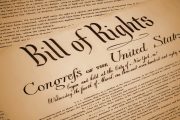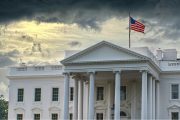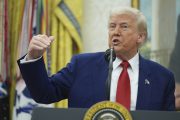
In his State Of The Union Address on February 12, President Obama cited a number of new initiatives on which he intended the federal government to take action. The area that understandably caused the biggest furor was the president’s reference to his proposals for increased federal restrictions on private firearm ownership, which he had outlined the previous month in a national address capitalizing on the December 2012 Sandy Hook Elementary School massacre.
Another proposal of the president focused on “one of the most fundamental rights of a democracy: the right to vote.” After the applause died down, President Obama declared: “When any Americans, no matter where they live or what their party, are denied that right because they can’t afford to wait for five or six or seven hours just to cast their ballot, we are betraying our ideals.” More enthusiastic applause.
“So tonight,” said the president, “I’m announcing a nonpartisan commission to improve the voting experience in America. And it definitely needs improvement.”
Last week, on March 28, just before the Easter weekend, the White House press office released President Obama’s latest executive order, on the “Establishment of the Presidential Commission of Election Administration.”
The creation of the new commission appears to portend even greater activism and interference by the administration in the upcoming mid-term elections than it has already shown itself capable of in the 2012 elections. President Obama’s Department of Justice, recall, sued to block state efforts at implementing voter identification laws that had been passed by state legislatures to prevent voter fraud. The administration did not hesitate to trespass on this constitutionally reserved right of the states, but joined with media allies and Democrat activists in denouncing these sensible measures as “voter suppression,” and, of course, suggesting that the measures were racist in nature and aimed at disenfranchising black and Hispanic voters. At the same time, the DOJ chose not to pursue action against militant Black Panther activists that were actually involved in voter suppression through threats and intimidation at polling places.
Section 3 of the new executive order states:
The Commission shall identify best practices and otherwise make recommendations to promote the efficient administration of elections in order to ensure that all eligible voters have the opportunity to cast their ballots without undue delay, and to improve the experience of voters facing other obstacles in casting their ballots, such as members of the military, overseas voters, voters with disabilities, and voters with limited English proficiency.
Interesting that the executive order mentions “the experience of voters facing other obstacles in casting their ballots, such as members of the military,” especially since the Obama administration has been credibly accused by many military veterans organizations of suppressing the military vote (see here and here).
A McClatchy News Service report last year noted:
In 2010, of the approximately 2 million military and overseas voters accounted for in data reported by the states to the Election Assistance Commission, only 4.6 percent of those voters were able to cast an absentee ballot that counted, according to the Military Voter Protection Project’s analysis of that data from the federal Election Assistance Commission, which tracks participation in voting.
This means that more than an astounding 95 percent of military and overseas voters failed to vote — for one reason or another. According to the Military Voter Protection Project, the Department of Defense under President Obama has consistently taken many actions to undermine the 2009 Military and Overseas Voter Empowerment Act (MOVE Act), which was enacted to facilitate access to absentee ballots for our military personnel serving overseas. Now the administration is citing those obstacles that it helped to create as proof of the need for even more interference in state elections.
The 2014 midterm congressional elections will be crucially important. Recent polls (see here, and here) show President Obama’s approval ratings sliding downhill since reelection, with only 47 percent of Americans saying they approve of his performance, down eight points since December, according to a Pew Research Center survey. Team Obama is well aware that the party of an incumbent president traditionally loses Senate and House seats in midterm elections. In times of economic trouble, the president’s party tends to get an extra-harsh shellacking.
The New American reported in February 2010 (Obama Eyes “Executive Orders” to Circumvent Congress) on the president’s plans to rule unconstitutionally by executive fiat. In the midterm elections later that year, the Democrats lost 63 seats in the U.S. House of Representatives, six in the Senate, and six governorships. Faced with congressional roadblocks to much of his agenda, President Obama has resorted to unconstitutional executive orders for enacting everything from an illegal immigrant amnesty, to vastly empowering the psychiatric industry, to dramatically expanding the Endangered Species Act, to declaring millions of acres protected habitat for the spotted owl (and off-limits to human use), to placing virtually everything under federal regulation and control.
Executive Order 13603’s “Emergency and Non-Emergency Powers”
One of the most frightening Obama edicts to come down the pike is Executive Order 13603 on “National Defense Resources Preparedness,” issued a little over a year ago, on March 16, 2012. This executive order is frightening because of its sweeping scope, explicitly declaring that the president and his designated Cabinet and agency heads have authority to commandeer and control:
all water,
all human and animal food,
all transportation,
all energy,
all construction materials,
all “health resources,”
all farm equipment,
all fertilizers,
all fuels,
… and much more.
President Obama declares in Executive Order 13603 his power to carry out these broad usurpations “By the authority vested in me as President by the Constitution and the laws of the United States of America, including the Defense Production Act of 1950, as amended (50 U.S.C. App. 2061 et seq.), and section 301 of title 3, United States Code, and as Commander in Chief of the Armed Forces of the United States.”
What should be particularly alarming to Americans is that Executive Order 13603 does not merely claim these powers during war time or during a “national emergency,” but explicitly and repeatedly states that these apply “in peacetime and in times of national emergency.” It further states that this “authority shall be used to promote the national defense, under both emergency and non-emergency conditions.”
Fedgov: “Don’t worry; We’ve got everything covered”
The all-encompassing scope of this edict is evident throughout the document, but the general flavor is indicated in Section 201, which states:
The authority of the President … to allocate materials, services, and facilities as deemed necessary or appropriate to promote the national defense, is delegated to the following agency heads:
(1) the Secretary of Agriculture with respect to food resources, food resource facilities, livestock resources, veterinary resources, plant health resources, and the domestic distribution of farm equipment and commercial fertilizer;
(2) the Secretary of Energy with respect to all forms of energy;
(3) the Secretary of Health and Human Services with respect to health resources;
(4) the Secretary of Transportation with respect to all forms of civil transportation;
(5) the Secretary of Defense with respect to water resources; and
(6) the Secretary of Commerce with respect to all other materials, services, and facilities, including construction materials …
To put a finer point on this executive power grab, Section 801 provides these definitions for the above-listed powers:
(a) ‘‘Civil transportation’’ includes movement of persons and property by all modes of transportation in interstate, intrastate, or foreign commerce … and related public storage and warehousing, ports, services, equipment and facilities, such as transportation carrier shop and repair facilities. ‘‘Civil transportation’’ also shall include direction, control, and coordination of civil transportation capacity regardless of ownership….
(b) ‘‘Energy’’ means all forms of energy including petroleum, gas (both natural and manufactured), electricity, solid fuels (including all forms of coal, coke, coal chemicals, coal liquification, and coal gasification), solar, wind, other types of renewable energy, atomic energy, and the production, conservation, use, control, and distribution (including pipelines) of all of these forms of energy.
(c) ‘‘Farm equipment’’ means equipment, machinery, and repair parts manufactured for use on farms in connection with the production or preparation for market use of food resources.
(d) ‘‘Fertilizer’’ means any product or combination of products that contain one or more of the elements nitrogen, phosphorus, and potassium for use as a plant nutrient.
(e) ‘‘Food resources’’ means all commodities and products, (simple, mixed, or compound), or complements to such commodities or products, that are capable of being ingested by either human beings or animals, irrespective of other uses to which such commodities or products may be put, at all stages of processing from the raw commodity to the products thereof in vendible form for human or animal consumption. ‘‘Food resources’’ also means potable water packaged in commercially marketable containers, all starches, sugars, vegetable and animal or marine fats and oils, seed, cotton, hemp, and flax fiber ….
(f) ‘‘Food resource facilities’’ means plants, machinery, vehicles (including on farm), and other facilities required for the production, processing, distribution, and storage (including cold storage) of food resources, and for the domestic distribution of farm equipment and fertilizer (excluding transportation thereof).
Section 308 states: “The head of each agency engaged in procurement for the national defense is delegated the authority of the President … to”:
(a) procure and install additional equipment, facilities, processes, or improvements to plants, factories, and other industrial facilities owned by the Federal Government and to procure and install Government-owned equipment in plants, factories, or other industrial facilities owned by private persons.
The dangers for corruption and coercion presented by this purported authority should be obvious. Favored companies and friends of the administration stand to gain huge taxpayer-supplied freebies, while those in disfavor may find their surviving factories, farms, plants, and facilities installed with “Government-owned equipment” to monitor, surveil, and report on their activities.
Obama Media Choir: “Nothing here to worry about”
Soon after President Obama issued Executive Order 13603, critics began pointing out the obvious dangers. One of the most influential condemnations of the edict was penned by Cato Institute Senior Fellow Jim Powell for Forbes.com entitled “Obama’s Plan To Seize Control Of Our Economy And Our Lives.”
As to be expected, liberal-left websites and commentators leapt to the president’s defense, assuring the public that there is nothing extraordinary in EO 13603 and nothing to be alarmed about. Snopes.com, for instance, said the executive order “was simply a minor updating of a similar order issued by President Bill Clinton in 1994 (which itself had decades-old predecessors) and amended several times since.” The Snopes entry cited an Ed Morrisey column at Hotair.com, who insists “This EO simply updates another EO (12919) that had been in place since June 1994, and amended several times since.” It also cited a Doug Mataconis column at outsidethebeltway.com, who echoed Morrisey, chiding that “the Executive Order itself is nothing more than a restatement of policy that has been in place for decades.”
There is some truth there, but it should actually be more troubling than comforting, if one treasures freedom. Much of the same exact wording concerning the claimed power of federal agencies to “allocate” all food, water, energy, transportation, etc. does indeed appear in President Clinton’s EO 12919 of June 3, 1994. And Clinton’s order also uses the term “in peacetime and in times of national emergency,” although the phrase “under both emergency and non-emergency conditions” is unique to Obama’s EO 13603.
Like Obama’s EO, Clinton’s EO also claims its authority from the Defense Production Act of 1950 (DPA) and its subsequent amendments. In fact, Congress has given successive presidents plausible (albeit illegitimate) constitutional cover for over six decades by regularly reauthorizing the DPA. The most recent example of this bi-partisan congressional complicity in establishing the basis for executive dictatorship is the Defense Production Act Reauthorization of 2009.
Therein one finds almost verbatim much of the wording of Obama’s EO 13603 that justifiably alarms so many people. The Defense Production Act Reauthorization of 2009 was introduced by Senator Christopher Dodd (D-Conn.) on September 16, 2009. The Library of Congress website informs us that the Senate (on that same day, September 16) “read” the bill three times and then passed it “without amendment by Unanimous Consent.” One week later it made a similar fast track through the House “on motion to suspend the rules and pass the bill Agreed to by voice vote.”
It is difficult to decide which is the more severe indictment of the senators: that they actually read the bill three times in one day (as officially claimed) and yet voted for it anyway, despite the apparent jarring conflict with the Constitution; or, that they cavalierly passed it without any of them truly reading its contents (the more believable scenario). Ditto for the House.
Nevertheless, as a result, defenders of EO 13603 claim its legitimacy is backed both by precedent and congressional enactment. However, neither the fact that previous presidents have issued similar (or even identical) executive orders, or that Congress has passed legislation purporting to authorize the said powers, can square the newly claimed powers with the restrictions placed on federal powers by our Constitution.
It is true that a major constitutional objection to many executive orders over the past 70 years is that they are executive usurpations of legislative authority that belongs to Congress. However, Congress itself is also bound by the Constitution and is not at liberty to legislate on any and all matters that may strike the whims of its members.
Article I, Section 1 of the U.S. Constitution states: “All legislative Powers herein granted shall be vested in a Congress of the United States.” The all-important operative phrase here is: herein granted. Those powers granted to Congress by the States and the People are delineated in Article I, and primarily in Section 8 of the same. Nowhere is Congress granted authority to “allocate” all food, water, transportation, energy, health resources, etc. And it has no constitutional power to “delegate” that authority to the president or any executive department or agency. Yet, that is precisely what has been happening for far to long with the Defense Production Act. As in the cases of the Patriot Act, the National Defense Authorization Act, and other similar pieces of legislation that claim exigencies of “national defense” and “national security,” Members of Congress have been all too willing to ignore their oaths to the Constitution and blindly vote for bills that our Founding Fathers would have recognized and denounced as the very definition of tyranny.
Time for a “National Conversation” on Liberty and the Constitution
It has become fashionable in political and public policy circles to demand a “national conversation” on matters the chattering classes deem important. Which is a way of saying the federal government must initiate a national policy on whatever issue it is they deem worthy of “conversing” about. Hence we have a National Conversation on Public Health and Chemical Exposures, a National Conversation on Education Reform, a National Conversation about Gun Violence, etc.
Is it really too extreme to suggest that maybe it is time to hold a “national conversation” on the dangers of runaway executive orders and the “emergency and non-emergency powers” claimed by the federal government? Is it not our responsibility as citizens to demand of our senators and representatives a firm resistance to all encroachments on our liberties? Is it really too difficult to imagine that another economic crisis, another terrorist attack, a banking collapse in Europe, war with Iran, war with North Korea (or fill in the blank with any number of other possible scenarios) might be used by President Obama (or a future president) to employ the full panoply of illegal executive powers to destroy what remains of our constitutional Republic? The fact that complete tyranny has not been fastened on us already and that we yet enjoy relative freedom of movement, expression, worship, etc., is no guarantee that the tyrannical potential embodied in the multitude of executive orders and laws already on the books will not be used to snuff out what freedoms we still possess.
James Madison, often called the “Father of the Constitution,” wisely advised:
It is proper to take alarm at the first experiment on our liberties. We hold this prudent jealousy to be the first duty of citizens and one of the noblest characteristics of the late Revolution. The freemen of America did not wait till usurped power had strengthened itself by exercise and entangled the question in precedents. They saw all the consequences in the principle, and they avoided the consequences by denying the principle. We revere this lesson too much soon to forget it.
Photo of President Barack Obama: AP Images
Related articles:
Obama’s Executive Order Authorizes Peacetime Martial Law
Obama Eyes “Executive Orders” to Circumvent Congress
Danger: Federal “Regulatory Cliff” Ahead
10,000 Commandments — The Hidden Tax
Regulators R Us: Feds Crank Up Regulations — on Everything
Obama Admin. Expands Endangered Species Act
Specious Endangerment: Obama Awards Spotted Owls 9.6 Million Acres
Obama Using “Endangered” Species to Kill Economy, Push Extreme Agenda
Bureaucrats “Giddy” With “Newly Minted Power”
Yes, Fellow Bubbas, They’re Coming for Your Guns




